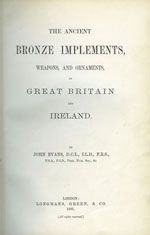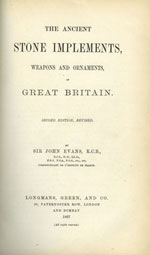Sir John Evans the Archaeologist
Evans was one of a small group of British scholars involved with the development of the field and profession of archaeology in Britain in the nineteenth century. Through the meticulous observation and recording of information gained from his extensive collection, he published the first comprehensive and systematic volumes on British prehistoric artefacts.
|
|||
The importance of his travels and subsequent dating of the finds cannot be over-emphasised. This established the existence of palaeolithic (Old Stone Age) man and destroyed the conventional chronology that had previously existed. In 1859 Evans had travelled to Abbeville and joined Joseph Prestwich, already there, to see the recent discoveries made by Boucher de Perthes in the gravels. Boucher had first discovered worked flint tools in the gravel pits on the Somme in 1847 and had put foward the theory that prehistoric man had existed there at an unprecedentedly early age. Evans and Prestwich authenticated this theory after examining these collections and the early river gravels that produced them. Evans presented a paper on this subject to the Society of Antiquaries in 1860, and later went on to investigate further sites that substantiated his early conclusions, namely Hoxne in Suffolk, Herne Bay in Kent and Biddenham in Bedfordshire. |
|||
Evans was not an academic but his travels and attendance at conferences meant he mixed in acadamic company. He began giving lectures and writing articles at a very early stage in his life. He also visited and occasionally took part in archaeological excavations. In 1854 he was busy excavating a Roman villa at Boxmoor, drawing the vases and tessellated pavements himself, while his wife Harriet coloured the prints. In the following April Evans read the paper about it to a group at St. Albans which provided him with a qualification for his election to the Society of Antiquaries in December 1855. While travelling to catch the boat for a business trip to Ireland in 1859 he went via Shrewsbury and visited the excavations at Wroxeter. His son Arthur recalls that he helped his father dig Roman pottery out of the cliffs at Dunwich in Suffolk whilst they were on holiday in 1860. It had been suggested in 1872 that Evans excavate the large Roman site of Verulamium, but the condition of the landowner Lord Verulum was that all finds should remain with him; consequently excavations on the site did not take place for another sixty years. During 1861 he found stone implements on the shores of Lough Neagh while on one of his regular business trips to the Belfast branchof Dickinson & Co, making subsequent visits and collecting more in 1864 and 1865. His correspondent and fellow-collector Robert Day from Cork informed him of the discovery of a large number of flints from Toome Bar where he had 'brought away forty stone celts and 300 worked flints' (Time and Chance). Evans regularly purchased objects from Day. Evans also collected objects locally. Anything found within a 12 mile radius of his home at Nash Mills was brought to him. He was away shooting when a Berkhamsted farmer brought in a gold torque and bronze objects. Mr. Allen, the finder, could not wait and would not leave the objects, so Evans had to write and arrange a meeting: 'Turned out to be found at Falaise and he managed to buy it' (Fanny's notes in her diary) . |
 The beach at Korsor in Zealand, Denmark |
Evans travelled extensively on business, attending or giving lectures, and on family holidays. He visited Denmark several times. On a recent visit to Denmark, members of the research team, Susanne Bangert and Christine Edbury, accompanied by Suzanne Anderson of the Department of Antiquities, took a walk along this small beach at Korsor, Zealand. This followed in the very footsteps of John Evans, who walked along the beach looking for flints whilst waiting for the ferry to take him across to Funen. |
|
Further References / Links:Joan Evans, Time and Chance: The Story of Arthur Evans and His Forebears (1943) Arthur MacGregor (ed.): Sir John Evans 1823-1908: Antiquity, Commerce and Natural Science in the Age of Darwin, (2008) Archaeological publications by Evans - see the Bibliography of Work by Sir John Evans |
|||


